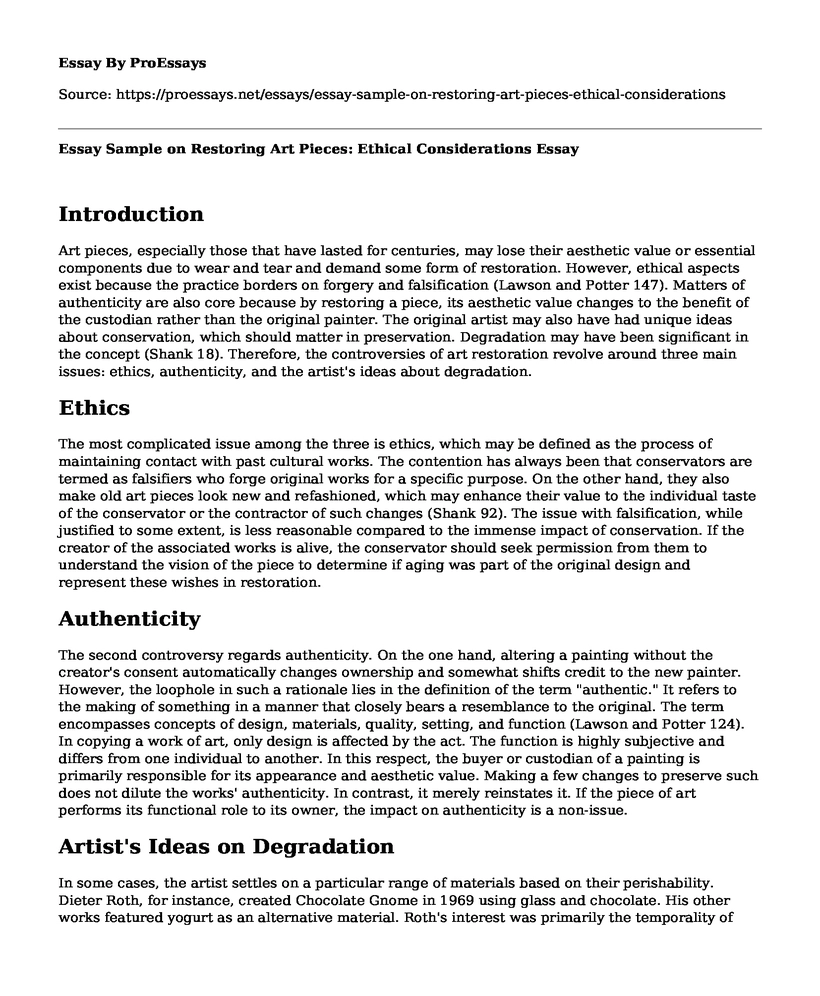Introduction
Art pieces, especially those that have lasted for centuries, may lose their aesthetic value or essential components due to wear and tear and demand some form of restoration. However, ethical aspects exist because the practice borders on forgery and falsification (Lawson and Potter 147). Matters of authenticity are also core because by restoring a piece, its aesthetic value changes to the benefit of the custodian rather than the original painter. The original artist may also have had unique ideas about conservation, which should matter in preservation. Degradation may have been significant in the concept (Shank 18). Therefore, the controversies of art restoration revolve around three main issues: ethics, authenticity, and the artist's ideas about degradation.
Ethics
The most complicated issue among the three is ethics, which may be defined as the process of maintaining contact with past cultural works. The contention has always been that conservators are termed as falsifiers who forge original works for a specific purpose. On the other hand, they also make old art pieces look new and refashioned, which may enhance their value to the individual taste of the conservator or the contractor of such changes (Shank 92). The issue with falsification, while justified to some extent, is less reasonable compared to the immense impact of conservation. If the creator of the associated works is alive, the conservator should seek permission from them to understand the vision of the piece to determine if aging was part of the original design and represent these wishes in restoration.
Authenticity
The second controversy regards authenticity. On the one hand, altering a painting without the creator's consent automatically changes ownership and somewhat shifts credit to the new painter. However, the loophole in such a rationale lies in the definition of the term "authentic." It refers to the making of something in a manner that closely bears a resemblance to the original. The term encompasses concepts of design, materials, quality, setting, and function (Lawson and Potter 124). In copying a work of art, only design is affected by the act. The function is highly subjective and differs from one individual to another. In this respect, the buyer or custodian of a painting is primarily responsible for its appearance and aesthetic value. Making a few changes to preserve such does not dilute the works' authenticity. In contrast, it merely reinstates it. If the piece of art performs its functional role to its owner, the impact on authenticity is a non-issue.
Artist's Ideas on Degradation
In some cases, the artist settles on a particular range of materials based on their perishability. Dieter Roth, for instance, created Chocolate Gnome in 1969 using glass and chocolate. His other works featured yogurt as an alternative material. Roth's interest was primarily the temporality of such pieces rather than their existence (Shank 113). The conservators and other stakeholders may disagree on the replacement material that has the same impact as the original and the parameters that, as in the case of Chocolate Gnome, determine the temporality mentioned above. Finding a practical solution in such cases can be tricky. A starting point, however, may be to keep the art piece in a pernicious form while seeking suitable restoration materials.
Conclusion
In conclusion, the restoration of artworks is a controversial subject that has sparked strong arguments from either side of the divide. Those against the practice consider it a devaluation of the pieces involved, while those who promote it claim it maintains the latter's aesthetic value. These issues notwithstanding, understanding the artist's point of view in creating the piece is crucial because their intentions should be paramount. Whatever route the custodian decides to go conservation should remain a top priority in maintaining the painting's value to ensure its longevity.
Works Cited
Lawson, Louise, and Deborah Potter. "Contemporary art, contemporary issues-conservation at Tate." Journal of the Institute of Conservation, vol. 40, no. 2, 2017, pp. 121-132.
Shank, Will. Conservation Issues in Modern and Contemporary Murals. Cambridge Scholars Publishing, 2015.
Cite this page
Essay Sample on Restoring Art Pieces: Ethical Considerations. (2023, Feb 27). Retrieved from https://proessays.net/essays/essay-sample-on-restoring-art-pieces-ethical-considerations
If you are the original author of this essay and no longer wish to have it published on the ProEssays website, please click below to request its removal:
- Films Analysis Essay on The Battleship Potemkin and Triumph of the Will
- Essay Example on Native Americans in Z Nation: Misrepresentation and Stereotypes
- Movie Analysis Essay on Life of Pi: A Journey of Belief, Discovery and Devotion
- Essay Example on Aladdin: Movie Soundtracks Enhancing the Production
- Essay Example on Zara: Leading the High Street Fashion Industry Since 1975
- America Joins World War II With Propaganda Support - Essay Sample
- Paper Example on Analysis of Cultural Dance: Abstrait & Clay Figures







